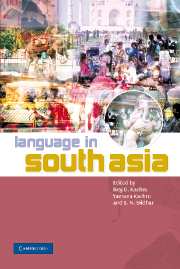Book contents
- Frontmatter
- Contents
- List of Figures
- List of Maps
- List of Tables
- Preface
- Acknowledgments
- List of Abbreviations
- Note on Transcription
- Introduction: languages, contexts, and constructs
- Part 1 Language history, families, and typology
- Part 2 Languages and their functions
- 3 Hindi–Urdu–Hindustani
- 4 Persian in South Asia
- 5 Major regional languages
- 6 Minority languages and their status
- 7 Tribal languages
- Part 3 Sanskrit and traditions of language study
- Part 4 Multilingualism, contact, and convergence
- Part 5 Orality, literacy, and writing systems
- Part 6 Language conflicts
- Part 7 Language and modernization
- Part 8 Language and discourse
- Part 9 Language and identity
- Part 10 Languages in diaspora
- References
- Subject Index
- Language Index
- Author Index
4 - Persian in South Asia
Published online by Cambridge University Press: 04 May 2010
- Frontmatter
- Contents
- List of Figures
- List of Maps
- List of Tables
- Preface
- Acknowledgments
- List of Abbreviations
- Note on Transcription
- Introduction: languages, contexts, and constructs
- Part 1 Language history, families, and typology
- Part 2 Languages and their functions
- 3 Hindi–Urdu–Hindustani
- 4 Persian in South Asia
- 5 Major regional languages
- 6 Minority languages and their status
- 7 Tribal languages
- Part 3 Sanskrit and traditions of language study
- Part 4 Multilingualism, contact, and convergence
- Part 5 Orality, literacy, and writing systems
- Part 6 Language conflicts
- Part 7 Language and modernization
- Part 8 Language and discourse
- Part 9 Language and identity
- Part 10 Languages in diaspora
- References
- Subject Index
- Language Index
- Author Index
Summary
Introduction
South Asia is linguistically and culturally a pluralistic region where not only different languages of the region coexist and affect each other, but, more important, foreign languages also get acculturated. Persian and English are the two foreign languages that have got acculturated in South Asia at different points of time. Acculturation implies a process of Indianization of the foreign language. In this chapter the word India is used interchangeably with South Asia to refer to India, Pakistan, Bangladesh, Nepal, Bhutan, and Sri Lanka. B. Kachru (1983b, 1992c) has provided an in-depth study of the process of Indianization in the context of Indian English. According to him the process is not a superficial one but results in a linguistic system that reflects an identity and lends authenticity to the nativized variety (B. Kachru 2001: 25). The emergence of two nativized varieties, that is Indian Persian and Indian English, is unique to the subcontinent. Not only this, the process of Indianization of both the foreign languages is identical. The Persian experience, resulting in the development of Urdu and Hindustani, appears to be far more intense than that of English at present (see Abidi 1981, 1998, 2000). It, however, needs to be mentioned that while the spread of Persian has come full circle in its approximately eight hundred years of history in South Asia, English is still a dominant language and its circle is far from complete.
- Type
- Chapter
- Information
- Language in South Asia , pp. 103 - 120Publisher: Cambridge University PressPrint publication year: 2008
- 7
- Cited by



